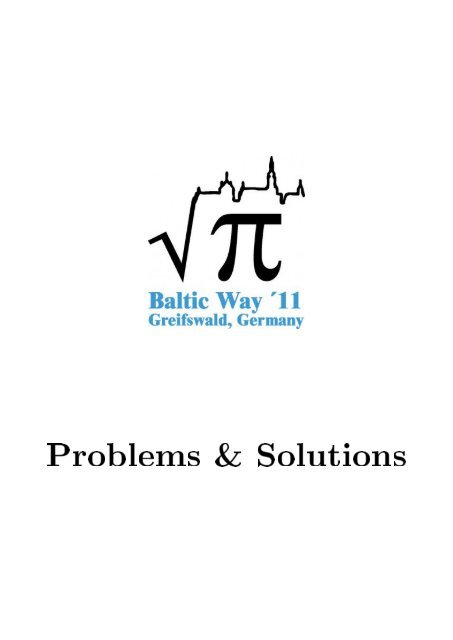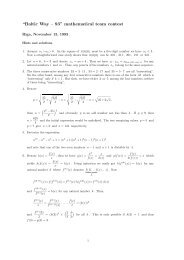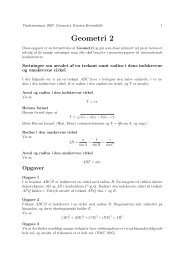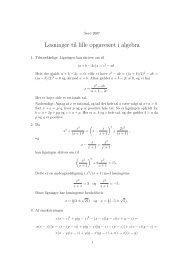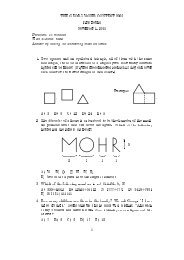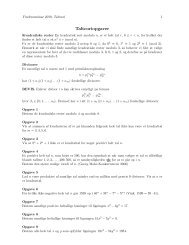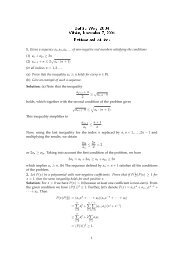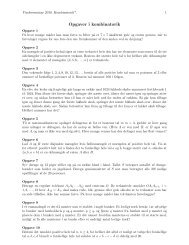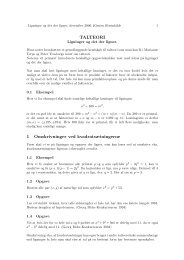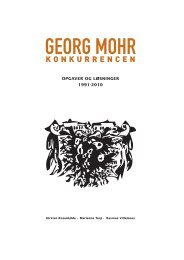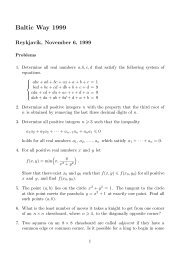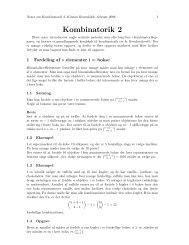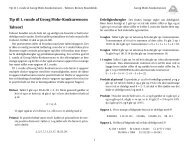Problems & Solutions - Baltic Way 2011
Problems & Solutions - Baltic Way 2011
Problems & Solutions - Baltic Way 2011
You also want an ePaper? Increase the reach of your titles
YUMPU automatically turns print PDFs into web optimized ePapers that Google loves.
<strong>Problems</strong> & <strong>Solutions</strong>
The 20 contest problems were submitted by 7 countries:<br />
Denmark (5)<br />
Finland (3)<br />
Germany (4)<br />
Norway (2)<br />
Poland (3)<br />
Russia (2)<br />
South Africa (1)<br />
Layout: L A TEX & TEX
<strong>Baltic</strong> <strong>Way</strong> <strong>2011</strong> <strong>Problems</strong> & <strong>Solutions</strong> Algebra<br />
A-1 DEN<br />
Algebra<br />
The real numbers x 1 , . . . , x <strong>2011</strong> satisfy<br />
x 1 + x 2 = 2x ′ 1 , x 2 + x 3 = 2x ′ 2 , . . . , x <strong>2011</strong> + x 1 = 2x ′ <strong>2011</strong><br />
where x ′ 1, x ′ 2, . . . , x ′ <strong>2011</strong> is a permutation of x 1 , x 2 , . . . , x <strong>2011</strong> . Prove that x 1 = x 2 = · · · = x <strong>2011</strong> .<br />
A-2 NOR<br />
Let f : Z → Z be a function such that, for all integers x and y, the following holds:<br />
f(f(x) − y) = f(y) − f(f(x)).<br />
Show that f is bounded, i.e. that there is a constant C such that<br />
for all integers x.<br />
−C < f(x) < C<br />
A-3 NOR<br />
A sequence a 1 , a 2 , a 3 , . . . of non-negative integers is such that a n+1 is the last digit of a n n + a n−1<br />
for all n > 2. Is it always true that for some n 0 the sequence a n0 , a n0 +1, a n0 +2, . . . is periodic?<br />
A-4 RUS<br />
Let a, b, c, d be non-negative reals such that a + b + c + d = 4. Prove the inequality<br />
a<br />
a 3 + 8 +<br />
b<br />
b 3 + 8 +<br />
c<br />
c 3 + 8 +<br />
d<br />
d 3 + 8 ≤ 4 9 .<br />
A-5 SAF<br />
Let f : R → R be a function such that<br />
f(f(x)) = x 2 − x + 1<br />
for all real numbers x. Determine f(0).<br />
3
<strong>Baltic</strong> <strong>Way</strong> <strong>2011</strong> <strong>Problems</strong> & <strong>Solutions</strong> Combinatorics<br />
C-1 FIN<br />
Combinatorics<br />
Let n be a positive integer. Prove that the number of lines which go through the origin and<br />
precisely one other point with integer coordinates (x, y), 0 ≤ x, y ≤ n, is at least n2<br />
4 .<br />
C-2 GER<br />
Let T denote the 15-element set {10a + b : a, b ∈ Z, 1 ≤ a < b ≤ 6}. Let S be a subset of T in<br />
which all six digits 1, 2, . . . , 6 appear and in which no three elements together use all these six<br />
digits. Determine the largest possible size of S.<br />
C-3 GER<br />
In Greifswald there are three schools called A, B and C, each of which is attended by at least<br />
one student. Among any three students, one from A, one from B and one from C, there are two<br />
knowing each other and two not knowing each other. Prove that at least one of the following<br />
holds:<br />
• Some student from A knows all students from B.<br />
• Some student from B knows all students from C.<br />
• Some student from C knows all students from A.<br />
C-4 GER<br />
Given a rectangular grid, split into m × n squares, a colouring of the squares in two colours<br />
(black and white) is called valid if it satisfies the following conditions:<br />
• All squares touching the border of the grid are coloured black.<br />
• No four squares forming a 2 × 2-square are coloured in the same colour.<br />
• No four squares forming a 2 × 2-square are coloured in such a way that only diagonally<br />
touching squares have the same colour.<br />
Which grid sizes m × n (with m, n ≥ 3) have a valid colouring?<br />
C-5 RUS<br />
Two persons play the following game with integers. The initial number is <strong>2011</strong> <strong>2011</strong> . The players<br />
move in turns. Each move consists of subtraction of an integer between 1 and 2010 inclusive,<br />
or division by <strong>2011</strong>, rounding down to the closest integer when necessary. The player who first<br />
obtains a non-positive integer wins. Which player has a winning strategy?<br />
4
<strong>Baltic</strong> <strong>Way</strong> <strong>2011</strong> <strong>Problems</strong> & <strong>Solutions</strong> Geometry<br />
G-1 FIN<br />
Geometry<br />
Let AB and CD be two diameters of the circle C. For an arbitrary point P on C, let R and S<br />
be the feet of the perpendiculars from P to AB and CD, respectively. Show that the length of<br />
RS is independent of the choice of P .<br />
G-2 DEN<br />
Let P be a point inside a square ABCD such that P A : P B : P C is 1 : 2 : 3. Determine the<br />
angle ∠BP A.<br />
G-3 DEN<br />
Let E be an interior point of the convex quadrilateral ABCD. Construct triangles △ABF ,<br />
△BCG, △CDH and △DAI on the outside of the quadrilateral such that the similarities<br />
△ABF ∼ △DCE, △BCG ∼ △ADE, △CDH ∼ △BAE and △DAI ∼ △CBE hold. Let P ,<br />
Q, R and S be the projections of E on the lines AB, BC, CD and DA, respectively. Prove<br />
that if the quadrilateral P QRS is cyclic, then<br />
EF · CD = EG · DA = EH · AB = EI · BC .<br />
G-4 POL<br />
The incircle of a triangle ABC touches the sides BC, CA, AB at D, E, F , respectively. Let<br />
G be a point on the incircle such that F G is a diameter. The lines EG and F D intersect at<br />
H. Prove that CH ‖ AB.<br />
G-5 POL<br />
Let ABCD be a convex quadrilateral such that ∠ADB = ∠BDC. Suppose that a point E on<br />
the side AD satisfies the equality<br />
AE · ED + BE 2 = CD · AE.<br />
Show that ∠EBA = ∠DCB.<br />
5
<strong>Baltic</strong> <strong>Way</strong> <strong>2011</strong> <strong>Problems</strong> & <strong>Solutions</strong> Number Theory<br />
N-1 DEN<br />
Number Theory<br />
Let a be any integer. Define the sequence x 0 , x 1 , . . . by x 0 = a, x 1 = 3 and<br />
x n = 2x n−1 − 4x n−2 + 3 for all n > 1.<br />
Determine the largest integer k a for which there exists a prime p such that p ka divides x <strong>2011</strong> − 1.<br />
N-2 DEN<br />
Determine all positive integers d such that whenever d divides a positive integer n, d will also<br />
divide any integer obtained by rearranging the digits of n.<br />
N-3 GER<br />
Determine all pairs (p, q) of primes for which both p 2 + q 3 and q 2 + p 3 are perfect squares.<br />
N-4 FIN<br />
Let p ≠ 3 be a prime number. Show that there is a non-constant arithmetic sequence of positive<br />
integers x 1 , x 2 , . . . , x p such that the product of the terms of the sequence is a cube.<br />
N-5 POL<br />
An integer n ≥ 1 is called balanced if it has an even number of distinct prime divisors. Prove<br />
that there exist infinitely many positive integers n such that there are exactly two balanced<br />
numbers among n, n + 1, n + 2 and n + 3.<br />
6
<strong>Baltic</strong> <strong>Way</strong> <strong>2011</strong> Algebra A-1<br />
A-1 DEN<br />
Algebra<br />
The real numbers x 1 , . . . , x <strong>2011</strong> satisfy<br />
x 1 + x 2 = 2x ′ 1 , x 2 + x 3 = 2x ′ 2 , . . . , x <strong>2011</strong> + x 1 = 2x ′ <strong>2011</strong><br />
where x ′ 1, x ′ 2, . . . , x ′ <strong>2011</strong> is a permutation of x 1 , x 2 , . . . , x <strong>2011</strong> . Prove that x 1 = x 2 = · · · = x <strong>2011</strong> .<br />
Solution 1 For convenience we call x <strong>2011</strong> also x 0 . Let k be the largest of the numbers<br />
x 1 , . . . , x <strong>2011</strong> , and consider an equation x n−1 + x n = 2k, where 1 ≤ n ≤ <strong>2011</strong>. Hence we<br />
get 2 max(x n−1 , x n ) ≥ x n−1 + x n = 2k, so either x n−1 or x n , say x n−1 , satisfies x n−1 ≥ k. Since<br />
also x n−1 ≤ k, we then have x n−1 = k, and then also x n = 2k − x n−1 = 2k − k = k. That is,<br />
in such an equation both variables on the left equal k. Now let E be the set of such equations,<br />
and let S be the set of subscripts on the left of these equations. From x n = k ∀n ∈ S we get<br />
|S| ≤ |E|. On the other hand, since the total number of appearances of these subscripts is 2|E|<br />
and each subscript appears on the left in no more than two equations, we have 2|E| ≤ 2|S|.<br />
Thus 2|E| = 2|S|, so for each n ∈ S the set E contains both equations with the subscript n<br />
on the left. Now assume 1 ∈ S without loss of generality. Then the equation x 1 + x 2 = 2k<br />
belongs to E, so 2 ∈ S. Continuing in this way we find that all subscripts belong to S, so<br />
x 1 = x 2 = · · · = x <strong>2011</strong> = k.<br />
Solution 2<br />
Again we call x <strong>2011</strong> also x 0 . Taking the square on both sides of all the equations<br />
and adding the results, we get<br />
∑<strong>2011</strong><br />
∑<strong>2011</strong><br />
∑<strong>2011</strong><br />
(x n−1 + x n ) 2 = 4 x ′2 n = 4 x 2 n ,<br />
n=1<br />
which can be transformed with some algebra into<br />
n=1<br />
n=1<br />
Hence the assertion follows.<br />
∑<strong>2011</strong><br />
(x n−1 − x n ) 2 = 0 .<br />
n=1<br />
7
<strong>Baltic</strong> <strong>Way</strong> <strong>2011</strong> Algebra A-2<br />
A-2 NOR<br />
Let f : Z → Z be a function such that, for all integers x and y, the following holds:<br />
f(f(x) − y) = f(y) − f(f(x)).<br />
Show that f is bounded, i.e. that there is a constant C such that<br />
−C < f(x) < C<br />
for all integers x.<br />
First, setting y = f(x) one obtains f(0) = 0. Secondly y = 0 yields f(f(x)) = 0 for all x, thus<br />
f(f(x) − y) = f(y).<br />
Setting x = 0 yields f(−y) = f(y), and finally y := −z yields<br />
f(f(x) + z) = f(−z) = f(z).<br />
If f(x) = 0 for all x, then f is obviously bounded. If on the other hand there exists an x 0 such<br />
that f(x 0 ) ≠ 0, then, with x = x 0 , the last equality gives that f is periodic with period |f(x 0 )|,<br />
and thus f must be bounded.<br />
8
<strong>Baltic</strong> <strong>Way</strong> <strong>2011</strong> Algebra A-3<br />
A-3 NOR<br />
A sequence a 1 , a 2 , a 3 , . . . of non-negative integers is such that a n+1 is the last digit of a n n + a n−1<br />
for all n > 2. Is it always true that for some n 0 the sequence a n0 , a n0 +1, a n0 +2, . . . is periodic?<br />
Since for n > 2, we actually consider the sequence mod 10, and ϕ(10) = 4, we have that the<br />
recursive formula itself has a period of 4. Furthermore, the subsequent terms of the sequence<br />
are uniquely determined by two consecutive terms. Therefore if there exist integers n 0 > 2 and<br />
k > 0 such that a n0 = a n0 +4k and a n0 +1 = a n0 +4k+1, then the sequence is periodic from a n0 on<br />
with period 4k. Consider the pairs (a 2+4j , a 3+4j ) for 0 ≤ j ≤ 100. Since there are at most 100<br />
possible different amongst these, there have to exist 0 ≤ j 1 < j 2 ≤ 100 such that a 2+4j1 = a 2+4j2<br />
and a 3+4j1 = a 3+4j2 . Choosing n 0 := 2 + 4j 1 we are done.<br />
Remark: Note, that if a 1 , a 2 both are between 0 and 9, then the recursion is invertible and the<br />
sequence can be extended to the left. By invertibility it then follows that the original sequence<br />
is actually periodic with the choice n 0 = 1. Similar arguments show, that in general, n 0 can be<br />
chosen to be 3.<br />
9
<strong>Baltic</strong> <strong>Way</strong> <strong>2011</strong> Algebra A-4<br />
A-4 RUS<br />
Let a, b, c, d be non-negative reals such that a + b + c + d = 4. Prove the inequality<br />
a<br />
a 3 + 8 +<br />
b<br />
b 3 + 8 +<br />
c<br />
c 3 + 8 +<br />
d<br />
d 3 + 8 ≤ 4 9 .<br />
By the means inequality we have a 3 + 2 = a 3 + 1 + 1 ≥ 3 3√ a 3 · 1 · 1 = 3a. Therefore it is<br />
sufficient to prove the inequality<br />
a<br />
3a + 6 +<br />
b<br />
3b + 6 +<br />
We can write the last inequality in the form<br />
c<br />
3c + 6 +<br />
d<br />
3d + 6 ≤ 4 9 .<br />
1<br />
a + 2 + 1<br />
b + 2 + 1<br />
c + 2 + 1<br />
d + 2 ≥ 4 3 .<br />
Now it follows by the harmonic and arithmetic means inequality:<br />
1<br />
( 1<br />
4 a + 2 + 1<br />
b + 2 + 1<br />
c + 2 + 1 )<br />
≥<br />
d + 2<br />
4<br />
(a + 2) + (b + 2) + (c + 2) + (d + 2) = 4<br />
4 + 2 + 2 + 2 + 2 = 1 3 .<br />
10
<strong>Baltic</strong> <strong>Way</strong> <strong>2011</strong> Algebra A-5<br />
A-5 SAF<br />
Let f : R → R be a function such that<br />
f(f(x)) = x 2 − x + 1<br />
for all real numbers x. Determine f(0).<br />
Let f(0) = a and f(1) = b.<br />
Then f(f(0)) = f(a).<br />
But f(f(0)) = 0 2 − 0 + 1 = 1. So f(a) = 1. (1)<br />
Also f(f(1)) = f(b).<br />
But f(f(1)) = 1 2 − 1 + 1 = 1. So f(b) = 1. (2)<br />
From (1), f(f(a)) = f(1).<br />
But f(f(a)) = a 2 − a + 1. So a 2 − a + 1 = b. (3)<br />
From (2), f(f(b)) = f(1), giving b 2 − b + 1 = b. So b = 1.<br />
Putting b = 1 in (3) gives a = 0 or 1.<br />
But a = 0 ⇒ f(0) = 0 ⇒ f(f(0)) = 0, contradicting (1).<br />
So a = 1, i.e. f(0) = 1.<br />
11
<strong>Baltic</strong> <strong>Way</strong> <strong>2011</strong> Combinatorics C-1<br />
C-1 FIN<br />
Combinatorics<br />
Let n be a positive integer. Prove that the number of lines which go through the origin and<br />
precisely one other point with integer coordinates (x, y), 0 ≤ x, y ≤ n, is at least n2<br />
4 .<br />
Let n ′ = [n/2] be the largest integer satisfying n ′ ≤ n/2. We solve the problem with n 2 − 3n ′2<br />
instead of n 2 /4, which is exactly what we are supposed to do if n is even and slighly better<br />
than our original goal if n is odd.<br />
A point is called relevant if both of its coordinates are integers between 1 and n, inclusively. A<br />
relevant point is called tiny if both of its coordinates are at most n ′ and large otherwise. Note<br />
that there are n ′2 tiny points. A line through the origin is called vicious if contains at least two<br />
relevant points.<br />
Consider any vicious line l. Suppose that l passes through exactly k vicious points and that<br />
P = (x, y) is that one among them that is closest to the origin. Defining P i = (x · i, y · i) for all<br />
integers i, the relevant points on l are P 1 , P 2 , . . . , P k . Since k ≥ 2, it follows that P = P 1 itself<br />
is tiny. Now let k ′ denote that positive integer for which P 1 , P 2 , . . . , P k ′ are the tiny points on l,<br />
whereasP k ′ +1, . . . , P k are the large points on l. Since P k ′ +1 is not tiny, the point P 2(k ′ +1) cannot<br />
be relevant, for which reason k ≤ 2k ′ + 1; in particular, it follows that k ≤ 3k ′ .<br />
Summing the inequality just obtained over all vicious lines, we learn that the number of all<br />
relevant points lying on vicious lines is at most three times the number of all tiny points, i.e.<br />
at most 3n ′2 . Thus there are at least n 2 − 3n ′2 relevant points not belonging to any vicious line.<br />
As expained in the beginning, this solves the problem.<br />
12
<strong>Baltic</strong> <strong>Way</strong> <strong>2011</strong> Combinatorics C-2<br />
C-2 GER<br />
Let T denote the 15-element set {10a + b : a, b ∈ Z, 1 ≤ a < b ≤ 6}. Let S be a subset of T in<br />
which all six digits 1, 2, . . . , 6 appear and in which no three elements together use all these six<br />
digits. Determine the largest possible size of S.<br />
Consider the numbers of T , which contain 1 or 2. Certainly, no 3 of them can contain all 6<br />
digits and all 6 digits appear. Hence n ≥ 9.<br />
Consider the partitions:<br />
12, 36, 45,<br />
13, 24, 56,<br />
14, 26, 35,<br />
15, 23, 46,<br />
16, 25, 34.<br />
Since every row is a partition of {1, 2, . . . , 6}, it contains all 6 digits, S can contain at most two<br />
numbers of each of the 5 rows, i.e. n ≤ 10.<br />
Now we will prove that n = 9 is the correct number. Therefore we assume that n = 10 and<br />
will exclude this case by contradiction. Certainly, there is a digit, say 1, which does not appear<br />
at least twice (otherwise at most 3 numbers are missing in S) and at most 4 times (otherwise<br />
this digit does not appear in the members of S at all). Obviously, every row of the above set of<br />
partitions contains exactly 2 members of S. W.l.o.g. assume that 12, 13 ∉ S and 16 ∈ S. Then<br />
consider the following partitions, where bold-faced numbers are members of S and numbers in<br />
italics are not:<br />
12 , 36, 45,<br />
13 , 24, 56,<br />
14, 26, 35,<br />
15, 23, 46,<br />
16, 25, 34.<br />
By 16, 45 ∈ S it follows 23 ∉ S and by 24, 36 ∈ S it follows 15 ∉ S. Now S is missing at least<br />
2 members (15,23) of the partition 15, 23, 46, which is a contradiction.<br />
13
<strong>Baltic</strong> <strong>Way</strong> <strong>2011</strong> Combinatorics C-3<br />
C-3 GER<br />
In Greifswald there are three schools called A, B and C, each of which is attended by at least<br />
one student. Among any three students, one from A, one from B and one from C, there are two<br />
knowing each other and two not knowing each other. Prove that at least one of the following<br />
holds:<br />
• Some student from A knows all students from B.<br />
• Some student from B knows all students from C.<br />
• Some student from C knows all students from A.<br />
Assume the contrary and let a be a student from A knowing as many students from B as<br />
possible. As a does not know all students from B, there is a student b from B not known to<br />
a. Similarly, we may pick a student c from C not known to b and then a student a ′ from A<br />
not known to c. Applying the assumption to the sets of students {a, b, c} and {a ′ , b, c}, we<br />
learn that a and c know each other other, and so do a ′ and b. As b knows a ′ but not a, we<br />
have a ≠ a ′ . Moreover, the maximality condition imposed on a tells us that some student b ′<br />
from B is known to a but not to a ′ . Now if b ′ and c knew each other, then any two students<br />
from {a, b ′ , c} would know one another, which is not possible. Thus b ′ and c do not know each<br />
other, but this means that no two students from {a ′ , b ′ , c} know one another, which is likewise<br />
impossible. Thereby the problem is solved.<br />
14
<strong>Baltic</strong> <strong>Way</strong> <strong>2011</strong> Combinatorics C-4<br />
C-4 GER<br />
Given a rectangular grid, split into m × n squares, a colouring of the squares in two colours<br />
(black and white) is called valid if it satisfies the following conditions:<br />
• All squares touching the border of the grid are coloured black.<br />
• No four squares forming a 2 × 2-square are coloured in the same colour.<br />
• No four squares forming a 2 × 2-square are coloured in such a way that only diagonally<br />
touching squares have the same colour.<br />
Which grid sizes m × n (with m, n ≥ 3) have a valid colouring?<br />
There exist a valid colouring iff n or m is odd.<br />
Proof. If, without loss of generality, the number of rows is odd, colour every second row black,<br />
as well as the boundary, and all other squares white. It is easy to check that this coloring is<br />
valid.<br />
If both n and m are even, there is no valid coloring. To prove this, consider the following graph<br />
G: The vertices are the squares, and edges are drawn between two diagonally adjacent squares<br />
A and B iff the two other squares touching both A and B at a side have the same color.<br />
This graph of a valid coloring has the following properties:<br />
• The corner squares have degree 1.<br />
• Squares at a side of the grid have degree 0 or 2.<br />
• Squares in the middle have degree 0, 2 or 4.<br />
• The “forbidden patterns” are equivalent to the statement that no two edges of the graph<br />
are intersecting.<br />
• If you put a checkboard pattern on the grid, no edge connects squares of different colours.<br />
• Hence, if m and n are even, the corner squares sharing a side of the grid are in different<br />
connected components of the graph.<br />
• Since the sum of degrees in each connected component is even, the opposing corner-squares<br />
have to be in the same connected component.<br />
• Hence, there is a path from each corner to the opposing one.<br />
But those two paths can not exist without intersecting, thus some forbidden pattern exists<br />
always, i.e. there is no valid colouring.<br />
15
<strong>Baltic</strong> <strong>Way</strong> <strong>2011</strong> Combinatorics C-5<br />
C-5 RUS<br />
Two persons play the following game with integers. The initial number is <strong>2011</strong> <strong>2011</strong> . The players<br />
move in turns. Each move consists of subtraction of an integer between 1 and 2010 inclusive,<br />
or division by <strong>2011</strong>, rounding down to the closest integer when necessary. The player who first<br />
obtains a non-positive integer wins. Which player has a winning strategy?<br />
Answer: the second player wins.<br />
Though the problem is taken from the recent article (A. Guo. Winning strategies for aperiodic<br />
subtraction games // arXiv: 1108.1239v2), it could be known for the smaller numbers, say, for<br />
2 instead of <strong>2011</strong>.<br />
The initial numbers N for which the second player has a winning strategy are those ones that<br />
have odd numbers of trailing 0’s in base <strong>2011</strong> (i.e. if the biggest power of <strong>2011</strong> that divides N<br />
is odd). The main difficulty of the problem is to invent this answer. The proof is trivial: each<br />
move of the first player makes this biggest power to be even, and after that the second player<br />
can make this power odd by a suitable move.<br />
16
•<br />
•<br />
<strong>Baltic</strong> <strong>Way</strong> <strong>2011</strong> Geometry G-1<br />
G-1 FIN<br />
Geometry<br />
Let AB and CD be two diameters of the circle C. For an arbitrary point P on C, let R and S<br />
be the feet of the perpendiculars from P to AB and CD, respectively. Show that the length of<br />
RS is independent of the choice of P .<br />
Solution. Let O be the centre of C. Then P , R, S, and O are points on a circle C ′ with diameter<br />
OP , equal to the radius of C. The segment RS is a chord in this circle subtending the angle<br />
BOD or a supplementary angle. Since the angle as well as radius of C ′ are independent of P ,<br />
so is RS.<br />
D •<br />
•<br />
P<br />
S<br />
•<br />
A<br />
•<br />
O<br />
•<br />
R<br />
•<br />
B<br />
C<br />
17
•<br />
<strong>Baltic</strong> <strong>Way</strong> <strong>2011</strong> Geometry G-2<br />
G-2 DEN<br />
Let P be a point inside a square ABCD such that P A : P B : P C is 1 : 2 : 3. Determine the<br />
angle ∠BP A.<br />
First Solution. Rotate the triangle ABP by 90 ◦ around B such that A goes to C and P is<br />
mapped to a new point Q. Then ∠P BQ = ∠P BC + ∠CBQ = ∠P BC + ∠ABP = 90 ◦ . Hence<br />
the triangle P BQ is an isosceles right-angled triangle, and ∠BQP = 45 ◦ . By Pythagoras<br />
P Q 2 = 2P B 2 = 8AP 2 . Since CQ 2 + P Q 2 = AP 2 + 8AP 2 = 9AP 2 = P C 2 , by the converse<br />
Pythagoras P QC is a right-angled triangle, and hence<br />
∠BP A = ∠BQC = ∠BQP + ∠P QC = 45 ◦ + 90 ◦ = 135 ◦ .<br />
A<br />
•<br />
B<br />
•<br />
P<br />
45 ◦<br />
• Q<br />
•<br />
D<br />
•<br />
C<br />
Second Solution. Let X and Y be the feet of the perpendiculars drawn from A and C to P B.<br />
Put x = AX and y = XP . Suppose without loss of generality that P A = 1, P B = 2, and<br />
P C = 3. Since the right angled triangles ABX and BCY are congruent, we have BY = x and<br />
CY = 2 + y. Applying Pythagoras’ Theorem to the triangles AP X and P Y C, we get<br />
x 2 + y 2 = 1 and (2 − x) 2 + (2 + y) 2 = 9.<br />
Substituting the former equation into the latter, we infer x = y, which in turn discloses<br />
∠BP A = 135 ◦ .<br />
A<br />
•<br />
x<br />
•<br />
X<br />
y<br />
•<br />
P<br />
•<br />
Y<br />
x<br />
B<br />
•<br />
•<br />
D<br />
•<br />
C<br />
18
<strong>Baltic</strong> <strong>Way</strong> <strong>2011</strong> Geometry G-3<br />
G-3 DEN<br />
Let E be an interior point of the convex quadrilateral ABCD. Construct triangles △ABF ,<br />
△BCG, △CDH and △DAI on the outside of the quadrilateral such that the similarities<br />
△ABF ∼ △DCE, △BCG ∼ △ADE, △CDH ∼ △BAE and △DAI ∼ △CBE hold. Let P ,<br />
Q, R and S be the projections of E on the lines AB, BC, CD and DA, respectively. Prove<br />
that if the quadrilateral P QRS is cyclic, then<br />
EF · CD = EG · DA = EH · AB = EI · BC .<br />
Solution. We consider oriented angles modulo 180 ◦ . From the cyclic quadrilaterals AP ES,<br />
BQEP , P QRS, CREQ, DSER and △DCE ∼ △ABF we get<br />
∠AEB = ∠EAB + ∠ABE = ∠ESP + ∠P QE<br />
= ∠ESR + ∠RSP + ∠P QR + ∠RQE<br />
= ∠ESR + ∠RQE = ∠EDC + ∠DCE<br />
= ∠DEC = ∠AF B ,<br />
so the quadrilateral AEBF is cyclic. By Ptolemy we then have<br />
EF · AB = AE · BF + BE · AF .<br />
This transforms by AB : BF : AF = DC : CE : DE into<br />
EF · CD = AE · CE + BE · DE .<br />
F<br />
A<br />
P<br />
B<br />
E<br />
S<br />
Q<br />
G<br />
I<br />
D<br />
R<br />
C<br />
H<br />
Since the expression on the right of this equation is invariant under cyclic permutation of the<br />
vertices of the quadrilateral ABCD, the asserted equation follows immediately.<br />
19
from A. Assume there are m people in A. It is sufficient to show that m ≥ 24.<br />
By the definition of A, for every person p ∉ A there exists a group G<br />
<strong>Baltic</strong> <strong>Way</strong> <strong>2011</strong> Geometry p ⊂ A ∪ {p} of 4 people which w<br />
G-4<br />
he restaurant together one day. But G p ⊄ A, so there are exactly 3 elements in A ∩ G p . In other wor<br />
y G p consists of 3 people from A and the person p. Also, for different people p 1 , p 2 ∉ A we obtain disti<br />
rsections G-4 A ∩ G POL<br />
p1 , A ∩ G p2 — otherwise the groups G p1 , G p2 would have 3 people in common, which<br />
assumptions The would incircle mean of a triangle that GABC p1 = touches G p2 , but thethis sidesisBC, notCA, possible, AB at since D, E, pF 1 , ∈respectively. G p1 and pLet<br />
1 ∉ G p2 .<br />
Thus theG number a point ofon people the incircle not in such A that (equal F Gto is a<strong>2011</strong> diameter. − m) The does lines not EGexceed and F Dthe intersect number at of 3-elem<br />
ets of A: H. Prove that CH ‖( AB. ) m<br />
<strong>2011</strong> ≤ m + = 1 3 6 (6m + m(m − 1)(m − 2)) = 1 6 m(m2 − 3m + 8).<br />
right hand Solution. side isWe increasing work the foropposite m ≥ 1direction. and is equal Suppose to 1794 that H for ′ ism the= point 23. Therefore where DF intersect m ≥ 24, as desire<br />
the line through C parallel to AB. We need to show that H ′ = H. For this purpose it suffices<br />
4. We work in the opposite direction.<br />
to prove that E, G, H ′ Suppose that H<br />
are collinear, which reduces ′ is the point where<br />
to showing that if G ′ DF intersect the line throu<br />
≠ E is the common<br />
arallel to AB. We need to show that H ′ = H. For this purpose it suffices to prove that E, G, H ′<br />
point of EH ′ and the incircle, then G ′ = G.<br />
near, which reduces to showing that if G ′ ≠ E is the common point of EH ′ and the incircle, then G ′ =<br />
C<br />
H<br />
G<br />
E<br />
D<br />
A<br />
F<br />
B<br />
Note that H ′ and B lie on the same side of AC. Hence CH ′ ‖ AB gives ̸ ACH ′ = 180 ◦ − ̸ CAB. Al<br />
Note that H<br />
e homothety with center ′ and B lie on the same side of AC. Hence CH<br />
D maps the segment BF to the ′ ‖ AB gives ∠ACH<br />
segment CH ′ . Thus ′ = 180<br />
the ◦ −∠BAC.<br />
equality BD = B<br />
Also,<br />
lies that CH ′ some homothety with center D maps the<br />
= CD = CE, i.e. the triangle ECH ′ segment BF to the segment CH<br />
is isosceles and<br />
′ . Thus the<br />
equality BD = BF implies that CH ′ = CD = CE, i.e. the triangle ECH ′ is isosceles and<br />
̸ CEH ′ = 1 2 (180◦ ̸ ECH ′ ) = 1 ∠H ′ EC = 1 2 ̸ CAB.<br />
2 (180◦ − ∠ECH ′ ) = 1∠BAC.<br />
2<br />
G ′ and H But ′ lieG ′ on andthe H ′ same lie on side the same of AC, sideso of AC, ̸ CEG so ∠G ′ = ′ EC ̸ CEH = ∠H ′ and ′ EC and consequently<br />
̸<br />
∠G<br />
EF G ′ F ′ E =<br />
= ̸<br />
∠G<br />
CEG ′ EC ′ = ̸∠H CEH ′ EC ′ = 1∠BAC<br />
1 2<br />
2 ̸ CAB<br />
so that<br />
hat<br />
∠G ′<br />
̸ AF G ′ F A = ∠G ′ F E + ∠EF<br />
= ̸ AF E + ̸ EF G ′ A =<br />
= 1∠BAC 2 (180◦ − + 1<br />
2 2<br />
̸ EAF (180◦ − ∠F<br />
) + 1 AE) = 90 ◦ .<br />
2 ̸ CAB = 90 ◦ .<br />
Hence F G ′ is a diameter of the incircle and the desired equality G ′ = G follows.<br />
ce F G ′ is a diameter of the incircle and the desired equality G ′ = G follows.<br />
Remark. A similar proof also works in the forward direction: one may compute ∠EHD =<br />
1∠ACB. Hence H lies on the circle centred at C that passes through D and E. Consequently<br />
2<br />
the triangle EHC is isosceles, wherefore<br />
∠ECH = 180 ◦ − 2∠GEC = 180 ◦ − ∠BAC.<br />
Thus the lines AB and CH are indeed parallel.<br />
20
<strong>Baltic</strong> <strong>Way</strong> <strong>2011</strong> Geometry G-5<br />
G-5 POL<br />
Let ABCD be a convex quadrilateral such that ∠ADB = ∠BDC. Suppose that a point E on<br />
the side AD satisfies the equality<br />
AE · ED + BE 2 = CD · AE.<br />
Show that ∠EBA = ∠DCB.<br />
Solution. Let F be the point symmetric to E with respect to the line DB. Then the equality<br />
∠ADB = ∠BDC shows that F lies on the line DC, on the same side of D as C. Moreover, we<br />
5. Let F be the point symmetric to E with respect to the line DB. Then the equality ̸ ADB = ̸ BDC<br />
have AE · ED < CD · AE, or F D = ED < CD, so in fact F lies on the segment DC.<br />
proves that F lies on the line DC, on the same side of D as C. Moreover, we have AE · ED < CD · AE, or<br />
F D = ED < CD, so in fact F lies on the segment DC.<br />
D<br />
F<br />
E<br />
C<br />
A<br />
B<br />
Note now that triangles DEB and DF B are congruent (symmetric with respect to the line DB), so<br />
̸ AEB = ̸ BF C. Also, we have<br />
Note now that triangles DEB and DF B are congruent (symmetric with respect to the line<br />
DB), so BE∠AEB 2 = CD = · ∠BF AE −C. AE Also, · ED we= have AE · (CD − ED) = AE · (CD − F D) = AE · CF.<br />
Therefore BE 2 = CD · AE − AE · ED = AE · (CD<br />
BE<br />
AE = CF − ED)<br />
BE = CF = AE · (CD − F D) = AE · CF.<br />
BF .<br />
Therefore<br />
This proves that the triangles BEA and CFBE<br />
B are similar, which gives ̸ ABE = ̸ BCF = ̸ BCD.<br />
AE = CF<br />
BE = CF<br />
BF .<br />
6. Let c n = b n + b n+1 + b n+2 + b n+3 . This is an even integer with absolute value at most 4. Note also<br />
that c n+1<br />
This − shows c n = b n+4<br />
that− the b n ∈ triangles {0, ±2} for BEA each and n. CF Thus, B are if the similar, assertion which is false, givesthen ∠EBA either = c∠F n ∈ CB {2, 4} = for all<br />
sufficiently ∠DCB, large asn, desired. or c n ∈ {−2, −4} for all sufficiently large n. In both cases we will obtain a contradiction<br />
by showing that the sequence (b n ) n≥1 contains infinitely many consecutive pairs 1, 1 as well as infinitely<br />
many consecutive pairs −1, −1.<br />
We have b 6<br />
k = b 6<br />
2k = 1 and 6 2k − 1 = (6 k − 1)(6 k + 1), where the factors 6 k − 1 and 6 k − 1 are relatively<br />
prime. Hence b 6 2k −1 = b 6k −1b 6k +1 and therefore for every k at least one of the pairs b 6k −1, b 6 k; b 6 k, b 6k +1;<br />
b 6 2k −1, b 6<br />
2k has to be of the form 1, 1. Also, the same pair of consecutive integers can be obtained in this way<br />
for at most two different values of k.<br />
Similarly, b 3<br />
k = b 3<br />
2k = −1 and 3 2k − 1 = (3 k − 1)(3 k + 1), where this time gcd(3 k − 1, 3 k + 1) = 2, so<br />
that b 3 2k −1 = −b 3 k −1b 3 k +1. Thus for every k at least one of the pairs b 3 k −1, b 3 k; b 3 k, b 3 k +1; b 3 2k −1, b 3<br />
2k is of<br />
the form −1, −1.<br />
7. We claim that k = 3. Obviously k = 2 is not enough: the numbers 1, 2 or 8, 9 have odd divisor sums.<br />
Now suppose that the sum σ(n) of all positive divisors of n is odd. Consider a decomposition n = 2 r · m,<br />
where r ≥ 0 and m is an odd positive integer. Then the set of odd divisors of n coincides with the set of<br />
odd divisors of m. Hence σ(n) has the same parity as σ(m). Also, σ(m) has the same parity as the number<br />
of divisors of m, since all of them are odd. But the divisors of m can be grouped into pairs (d, m/d), where<br />
d ≤ √ m, except for the divisor √ m if it is an integer. It follows that the number of divisors of m is odd<br />
if and only if m is a perfect square. Hence the σ(n) 21 is odd if and only if n is a perfect square or a perfect<br />
square multiplied by 2.
<strong>Baltic</strong> <strong>Way</strong> <strong>2011</strong> Number Theory N-1<br />
N-1 DEN<br />
Number Theory<br />
Let a be any integer. Define the sequence x 0 , x 1 , . . . by x 0 = a, x 1 = 3 and<br />
x n = 2x n−1 − 4x n−2 + 3 for all n > 1.<br />
Determine the largest integer k a for which there exists a prime p such that p ka divides x <strong>2011</strong> − 1.<br />
Let y n = x n − 1. Hence<br />
y n = x n −1 = 2(y n−1 +1)−4(y n−2 +1)+3−1 = 2y n−1 −4y n−2 = 2(2y n−2 −4y n−3 )−4y n−2 = −8y n−3<br />
for all n > 2. Hence<br />
x <strong>2011</strong> − 1 = y <strong>2011</strong> = −8y 2008 = · · · = (−8) 670 y 1 = 2 <strong>2011</strong> .<br />
Hence k = <strong>2011</strong>.<br />
22
<strong>Baltic</strong> <strong>Way</strong> <strong>2011</strong> Number Theory N-2<br />
N-2 DEN<br />
Determine all positive integers d such that whenever d divides a positive integer n, d will also<br />
divide any integer obtained by rearranging the digits of n.<br />
Answer: d = 1, d = 3 or d = 9. It is known that 1, 3 and 9 have the given property. Assume<br />
that d is a k digit number such that whenever d divides an integer n, d will also divide any<br />
integer m having the same digits as n . Then there exists a k + 2 digit number 10a 1 a 2 . . . a k<br />
which is divisible by d. Hence a 1 a 2 · · · a k 10 and a 1 a 2 · · · a k 01 are also divisible by d. Since<br />
a 1 a 2 · · · a k 10 − a 1 a 2 · · · a k 01 = 9, d divides 9, and hence d = 1, d = 3 or d = 9 as stated.<br />
23
<strong>Baltic</strong> <strong>Way</strong> <strong>2011</strong> Number Theory N-3<br />
N-3 GER<br />
Determine all pairs (p, q) of primes for which both p 2 + q 3 and q 2 + p 3 are perfect squares.<br />
Answer. There is only one such pair, namely (p, q) = (3, 3).<br />
Proof. Let the pair (p, q) be as described in the statement of the problem.<br />
1.) First we show that p ≠ 2. Otherwise, there would exist a prime q for which q 2 + 8 and<br />
q 3 + 4 are perfect squares. Because of q 2 < q 2 + 8, the second condition gives (q + 1) 2 q 2 + 8<br />
and hence q 3. But for q = 2 or q = 3 the expression q 3 + 4 fails to be a perfect square.<br />
Hence indeed p ≠ 2 and due to symmetry we also have q ≠ 2.<br />
2.) Next we consider the special case p = q. Then p 2 (p + 1) is a perfect square, for which<br />
reason there exists an integer n satisfying p = n 2 − 1 = (n + 1)(n − 1). Since p is prime, this<br />
factorization yields n = 2 and thus p = 3. This completes the discussion of the case p = q.<br />
3.) So from now on we may suppose that p and q are distinct odd primes. Let a be a positive<br />
integer such that p 2 + q 3 = a 2 , i.e. q 3 = (a + p)(a − p). If both factors a + p and a − p were<br />
divisible by q, then so were their difference 2p, which is absurd. So by uniqueness of prime<br />
factorization we have a+p = q 3 and a−p = 1. Subtracting these equations we learn q 3 = 2p+1.<br />
Due to symmetry we also have p 3 = 2q + 1. Now if p < q, then q 3 = 2p + 1 < 2q + 1 = p 3 ,<br />
which gives a contradiction, and the case q < p is excluded similarly.<br />
Thereby the problem is solved.<br />
24
<strong>Baltic</strong> <strong>Way</strong> <strong>2011</strong> Number Theory N-4<br />
N-4 FIN<br />
Let p ≠ 3 be a prime number. Show that there is a non-constant arithmetic sequence of positive<br />
integers x 1 , x 2 , . . . , x p such that the product of the terms of the sequence is a cube.<br />
Let a 1 , a 2 , . . . , a p be any arithmetic sequence of positive integers and let P be the product of<br />
the terms of this sequence. For any n, the sequence P n a 1 , P n a 2 , . . . , P n a p is also arithmetic,<br />
and the product of terms is P np+1 . Now either p ≡ 1 mod 3 or p ≡ −1 mod 3. In the former<br />
case, 2p + 1 = 3q for some q and in the latter case, 1p + 1 = 3q for some q. So we can choose<br />
either x i = P 2 a i or x i = P a i to obtain the sequence we are looking for.<br />
25
<strong>Baltic</strong> <strong>Way</strong> <strong>2011</strong> Number Theory N-5<br />
N-5 POL<br />
An integer n ≥ 1 is called balanced if it has an even number of distinct prime divisors. Prove<br />
that there exist infinitely many positive integers n such that there are exactly two balanced<br />
numbers among n, n + 1, n + 2 and n + 3.<br />
We argue by contradiction. Choose N so large that no n ≥ N obeys this property. Now we<br />
partition all integers ≥ N into maximal blocks of consecutive numbers which are either all<br />
balanced or not. We delete the first block from the following considerations, now starting from<br />
N ′ > N. Clearly, by assumption, there cannot meet two blocks with length ≥ 2. It is also<br />
impossible that there meet two blocks of length 1 (remember that we deleted the first block).<br />
Thus all balanced or all unbalanced blocks have length 1. All other blocks have length 3, at<br />
least.<br />
Case 1: All unbalanced blocks have length 1.<br />
We take an unbalanced number u > 2N ′ + 3 with u ≡ 1 (mod 4) (for instance u = p 2 for an<br />
odd prime p). Since all balanced blocks have length ≥ 3, u − 3, u − 1, and u + 1 must be<br />
balanced. This implies that (u − 3)/2 is unbalanced, (u − 1)/2 is balanced, and (u + 1)/2 is<br />
again unbalanced. Thus {(u − 1)/2} is an balanced block of length 1 — contradiction.<br />
Case 2: All balanced blocks have length 1.<br />
Now we take a balanced number b > 2N ′ + 3 with b ≡ 1 (mod 4) (for instance b = p 2 q 2 for distinct<br />
odd primes p, q). By similar arguments, (b−3)/2 is balanced, (b−1)/2 is unbalanced, and<br />
(b+1)/2 is again balanced. Now the balanced block {(b−1)/2} gives the desired contradiction.<br />
26


